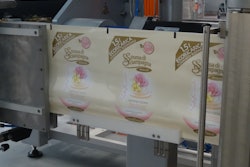1. Integration of the bagger with the scale.
The scale and the bagger are not always from the same vendor, and frequently are not from the same country. Two of the larger scale manufacturers are in Japan, and the majority of baggers are made in the U.S., the U.K., Germany, and Australia. These pieces of equipment are usually integrated at the packager’s plant. Care must be taken to understand the “stack-up”, or the total vertical elevation of the scale and bagger, well in advance of installation.
Often, the scales are mounted to an overhead platform, and the bagger sits on the floor. Typically the platform is designed and erected prior to the arrival of the scale and bagger on-site. If the engineering is not done properly, machines don’t fit! If there is a metal detector placed between the scale and the bagger, that adds another layer of complexity in the design.
For fragile products (snack foods, cookies, etc.), minimizing the drop from the feed system to the scale to the bagger to the discharge conveyor is the key to good design. Also, if the bag is going into a tray that will sit on the retail shelf, ensure proper orientation of the bag exiting the bagger and prior to tray loading, so that the bag faces the right way at retail.
Regarding controls, the communication between the scale and the bagger is important. Does the scale tell the bagger it is ready with a charge, or does the bagger tell the scale it is ready to make a bag? There is also the downstream machine that needs to be ready for the bag to be sent.
Bottom line: Take time to really look at the entire system, interface points, product drops, bag orientation, operator access on platforms, space for cleaning, etc., because once it’s installed, it’s hard to change.
2. Controlling the amount of air in the package.
Air trapped in the bag can be a good thing (for product protection) and a nightmare on secondary packaging. It can make loading into a carton or tray very difficult and can require additional components or features to allow the downstream equipment to function properly. Sometimes packages are flushed with an inert gas to extend the shelf life of the product. This is very common in snack foods (for example, chips and nuts). F/f/s vendors offer devices to remove some of the air with stationary guides or plows, as well as with “adjustable bag deflators,” which can be mounted to the horizontal sealing jaws. Changing their position can modify the amount of air in the bag.
3. The design of the seal.
There are a multitude of seal designs and knife types. General types for backseals are fin and lap seals. Different films require different seal jaw materials and designs. Bags can have gussets, flat bottoms, or four-corner side seals to improve presence on the shelf. Within the seal, there may be easy-open features that can be designed into the seal jaws. Extremely large seals may be a waste of material and provide an opportunity for optimization. The package designer and the equipment engineer should work together with the equipment vendor to determine the optimum seal design. Variables such as serration design (pitch, angle, depth), impressions per inch, total number of impressions, orientation of serrations (horizontal versus vertical versus diagonal), and knife type are decisions that need to be made. These are great areas to rely on the expertise of both the packaging material and packaging equipment suppliers.
Liked this article? Download the entire playbook here.


























